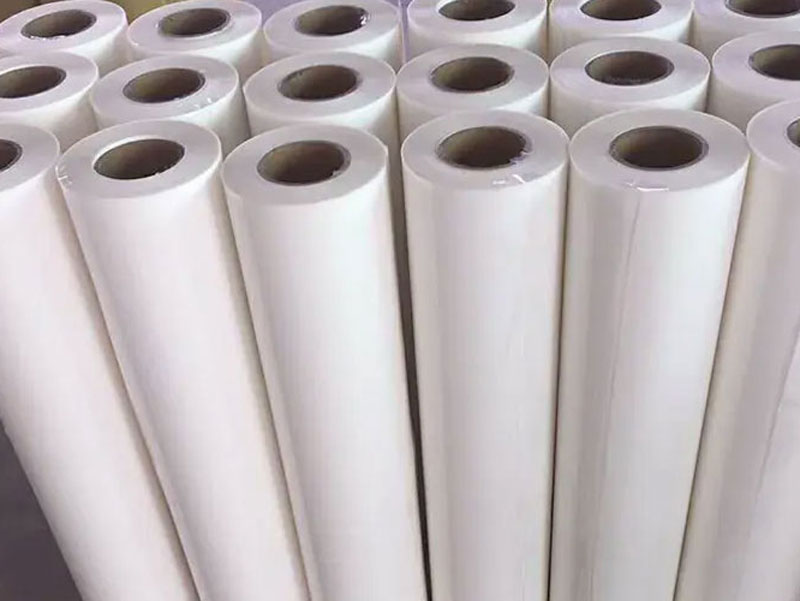In the world of adhesive technology and industrial manufacturing, hot melt adhesive films play a crucial role. These films, widely used in textiles, automotive interiors, electronics, packaging, and more, are typically produced in large sheets. However, to meet various application needs, it is essential to convert these full sheets into smaller, manageable rolls. This article will explore the efficient process of cutting full sheet hot melt adhesive films into small rolls using specialized cutting machines, focusing on techniques, equipment, advantages, and best practices.

What Are Hot Melt Adhesive Films?
Before diving into the cutting process, let’s briefly understand what hot melt adhesive films are. Hot melt adhesive (HMA) films are solid adhesive films that melt upon heating and adhere instantly when pressed against substrates. They offer excellent bonding strength, flexibility, and fast processing speed, making them highly popular in industrial laminating and bonding operations.
Hot melt adhesive films are commonly produced in large sheets or rolls for ease of storage and transport. However, many applications require smaller rolls that can be fed directly into bonding or lamination machines.
Why Cut Full Sheets Into Small Rolls?
Ease of Handling and Use
Large sheets are bulky and difficult to handle manually in production lines. Cutting these sheets into smaller rolls makes them easier to transport, store, and feed into downstream equipment.Customization for Application
Different bonding jobs may require varying widths or lengths of adhesive films. Cutting to custom sizes ensures optimal usage without waste.Automation Compatibility
Modern lamination and bonding machines usually require adhesive film in roll form. Small rolls can be automatically fed, improving production efficiency.Reduction in Waste and Cost
Proper cutting minimizes material wastage and aligns product size to precise requirements, lowering costs.
The Cutting Process: How It Works
Cutting hot melt adhesive films from full sheets into small rolls requires precision equipment capable of handling delicate materials without damaging their adhesive properties.
Step 1: Preparation of Full Sheets
Full sheets of hot melt adhesive films are usually unwound from larger master rolls or prepared in sheet form by extrusion or calendaring. These sheets must be aligned properly on the cutting machine.
Step 2: Loading Into the Cutting Machine
The sheets are placed on the cutting machine’s feeding platform. The machine may use rollers or clamps to hold the sheet steady, ensuring precise movement.
Step 3: Precision Cutting
Cutting machines for hot melt adhesive films typically use rotary knives, guillotine cutters, or laser cutters depending on the film thickness and production requirements. The cutting width and length can be adjusted to produce rolls of exact dimensions.
Rotary Blade Cutting: A common choice for continuous cutting of films. It ensures clean edges and fast processing.
Guillotine Cutting: Ideal for thicker films or batch processing of sheets.
Laser Cutting: Offers high precision with minimal mechanical stress but may be costly.
Step 4: Rewinding Into Rolls
Once cut, the adhesive film strips are rewound onto cores to form smaller rolls. The rewinding tension is carefully controlled to avoid stretching or damaging the film.
Step 5: Quality Inspection and Packaging
The finished rolls undergo quality inspection to check for defects such as uneven edges, wrinkles, or adhesive contamination. Rolls are then packaged for shipment or storage.

Key Features of Hot Melt Adhesive Film Cutting Machines
When selecting a cutting machine for hot melt adhesive films, consider the following features:
Precision Cutting: To ensure clean, straight edges without fraying or damage.
Adjustable Width and Length Settings: For customized roll sizes.
Automated Feeding and Rewinding System: Improves efficiency and reduces manual labor.
Non-Contact Cutting Options: Laser cutters minimize contact, preserving film integrity.
Tension Control: Critical to maintain consistent film thickness and adhesion.
User-Friendly Interface: Simplifies operation and reduces errors.
Advantages of Using Cutting Machines for Hot Melt Adhesive Films
High Efficiency: Automated cutting and rewinding significantly speed up production.
Consistent Quality: Precision equipment ensures uniform roll sizes and quality.
Cost-Effective: Reduces manual labor and material waste.
Versatility: Machines can handle various film thicknesses and materials.
Safety: Modern machines are designed with safety features to protect operators.
Best Practices for Cutting Hot Melt Adhesive Films
Maintain Optimal Machine Settings
Adjust cutting speed, blade sharpness, and tension control according to the specific film type.Use Suitable Blades
Replace blades regularly to avoid rough edges or film damage.Regular Maintenance
Clean and service the machine to prevent dust or adhesive buildup that can affect cutting quality.Quality Control
Implement inspection checkpoints post-cutting to detect defects early.Proper Storage of Rolls
Store the cut rolls in a clean, dry environment to maintain adhesive quality.
Applications of Small Rolls of Hot Melt Adhesive Films
Once cut into small rolls, hot melt adhesive films are widely used in industries such as:
Textile and Apparel: For lamination and bonding of fabrics and membranes.
Automotive: Interior panel assembly and upholstery bonding.
Electronics: Insulation and component assembly.
Packaging: Sealing and laminating flexible packaging materials.
Medical Devices: Assembly of disposable medical products.
Conclusion
Cutting full sheet hot melt adhesive films into small rolls with specialized cutting machines is a vital process that enhances product usability, efficiency, and quality in multiple industries. Leveraging precision cutting technology, automated feeding, and rewinding systems can significantly boost manufacturing productivity and ensure consistent product performance.
For manufacturers and processors of hot melt adhesive films, investing in the right cutting machine and adopting best practices is crucial to stay competitive and meet diverse customer needs.
